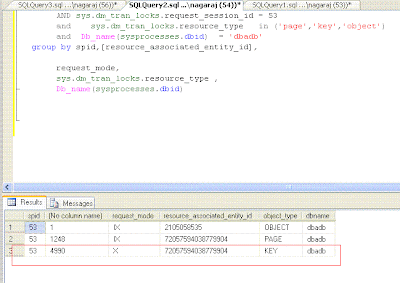Lock escalation is a event which occurs when SQL Server decides to upgrade a lock at a lower level hierarchy to a lock to a table level lock., In other words, when a particular query obtains a large number of row level locks/ page level locks, SQL Server decides that instead of creating and granting number of row level/page level locks, it is effective to grant a single table level lock. Or to be precise,
SQL Server upgrades the row/page level locks to table level locks. The above process is termed as lock escalation.
Lock escalation is good, as it reduces the overhead in maintaining a large number of smaller level locks. A lock structure is about occupies about 100 bytes of memory and too many locks can cause a memory pressure.Similarly applying,granting , and releasing locks for each row or page is a resource consuming processes which can be reduced by lock escalation. However, Lock escalation also reduces concurrency. ie, If a query causes lock escalation, then the query obtains a full table level lock, and another query attempting to access the table will have to wait till the first query releases the lock.
How SQL Server decides when to escalate lock ?
* When a query consumes more than 5000 locks per index / heap.
* When the lock monitor consumes more than 40% of the static memory or non AWE alloted memory.
So Let us quickly see lock escalation in action. Consider the following query
SET ROWCOUNT 4990
GO
BEGIN TRAN
UPDATE orders
SET order_description = order_description + ' '
--Rollback
The orders table has a clustered index. Row level locks will be taken on the index keys. SET ROWCOUNT ensures that only 4990 rows are updated by the query. I am leaving the transaction open ( without committing or rolling back ) , so that we can see the number of locks held by the query.
Fire the following query to check the locks held by the above script. The query lists the count of locks for each lock type and object. Note that the session id for the above script on my machine was 53. So filtering by the same.
SELECT spid,
COUNT(*),
request_mode,
[resource_associated_entity_id],
sys.dm_tran_locks.resource_type AS object_type,
Db_name(sysprocesses.dbid) AS dbname
FROM sys.dm_tran_locks,
sys.sysprocesses
OUTER APPLY Fn_get_sql(sql_handle)
WHERE spid = 53
AND sys.dm_tran_locks.request_session_id = 53
AND sys.dm_tran_locks.resource_type IN ( 'page', 'key', 'object' )
AND Db_name(sysprocesses.dbid) = 'dbadb'
GROUP BY spid,
[resource_associated_entity_id],
request_mode,
sys.dm_tran_locks.resource_type,
Db_name(sysprocesses.dbid)
As one may notice, we can find 4990 key locks / row level locks. Let us rollback transaction and modify the script to use 5000 or more locks.
SET ROWCOUNT 5000
GO
BEGIN TRAN
UPDATE orders
SET order_description = order_description + ' '
--Rollback
Now let us fire the same query on sys.dm_tran_locks. we obtain a single exclusive lock on the table/object. There are no key or row level locks as SQL Server as per its rule has escalated the row level locks to a table level lock.
SQL Server 2005 had a server wide setting to disable lock escalations. On SQL Server 2005, when the trace flag 1211/1224 are set, no query is allowed to escalate locks on the entire server. Ideally, we would like to have it as a object/table level setting which was provided by SQL Server 2008. SQL Server 2008 allows one to disable lock escalations at table/ partition levels.
Consider the following command in SQL 2k8
ALTER TABLE orders SET CONSTRAINT (LOCK_ESCALATION = DISABLE )
GO
The ALTER TABLE command's LOCK_ESCALATION property accepts three values.
* Disable -> Disables lock escalation ( Except a few exceptions . Refer Books online for details )
* Table -> Allows SQL Server to escalate to table level. That is the default setting.
* Auto -> Escalation will be partition level if the table is partitioned. Else escalation is always up to table level.
Let us rollback the open transaction created earlier and run the ALTER TABLE command posted above to disable lock escalations. Now let us run the same script to update 5000 records again and see if lock escalation has actually occurred.
As you may now notice, for the same 5000 rows, there is no lock escalation occuring this time as we have disabled it using the ALTER TABLE command. The picture shows 5000 key/row locks which is not possible at the default setting of lock escalation.
The intention behind this post was to introduce lock escalation, show how it works and also explain the new option provided to change lock escalation setting SQL Server 2008. Upcoming posts, we will dive deeper into the topic and understand when and under what circumstances can we play with lock escalation setting.
Monday, November 29, 2010
Lock escalation : SQL Server 2008
Subscribe to:
Post Comments (Atom)




11 comments:
I'm still not familiar with Lock escalation because my instructor in my Sql training is not discussing this topic so far. I'm happy I read it.
Hi Nagaraj,
even i was not very comfortable with Locking Escalation.. But after reading your post, i could understand clearly.. thank you very much for ur post... we are expecting more posts from u in future...
Balaji, Chennai.
Hi
After going through lot of posts i got confused, but with your post i got the clear idea.
Thank you..
Thxs Sanjeev and balaji
thanks Jonathan
simple and great.. got some good idea after reading your post..
Glad..i got to read this post.Thanks Nag.
Got a clear idea. Thank you very much.
You are the man Nagaraj, thanks for the easy to understand post!
This is good one too:
lock escalation explained
Nice information.Thanks a lot
cloud servers in chennai
Post a Comment